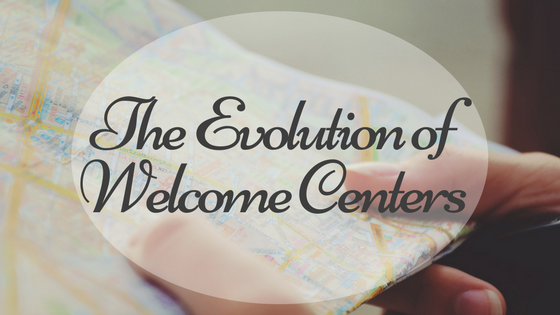The Evolution of Welcome Centers
Welcome centers were created to provide travelers with helpful information to improve their stay. They provide suggestions on things to do and aim to convince visitors to stay a little longer. Visitors often needed to seek out these centers to get brochures and maps, within a destination or at a highway stop on the way.
Over time, welcome centers have changed based on visitor habits. The “what” is the same. Travelers are still looking for information about a destination. But where they’re looking and how they want the information has changed completely. What started as a brochure rack with printed guides has evolved to beautifully-designed buildings with impressive displays.
Changing Location
Visitor centers should be where visitors already are. Travelers don’t want to go out of their way – in a city they’re unfamiliar with – to find a welcome center. Destinations are starting to install digital kiosks in popular attractions such as hotels, shopping malls and sporting complexes. For example, Seneca County set up a digital visitor concierge platform inside of del Lago Resort and Casino. Visitors can now plan their next steps by viewing nearby restaurants, shops, and attractions.
Promoting nearby places is key. The Finger Lakes Visitors Connection, the TPA for Ontario County, created high quality, interactive visitor experiences in its gateway hubs or communities. These informative visitor experiences – ranging from signs with a map to digital concierge platforms – promote other gateway hubs in the county. This gateway concept not only creates community connections, it fosters extended stays and repeat visitation within the county.
Fresh Content
In December 2016, the New York State governor’s office announced $55 million in funding to open ten welcome centers across New York State. (The Finger Lakes vacation region is fortunate to have three of these new welcome centers!) Each welcome center takes into consideration how travelers want to consume information. Visitors want to be entertained. They want facts without having to read much. Visitor centers are evolving to include high-res photography, videos, hands-on exhibits – even virtual reality. The pandemic challenged this further. QR codes replaced hard-copy information and high-touch surfaces. And tourism partners were required to keep their digital footprint (websites, Google, social media) up to date on current hours and offerings.
Each of these I Love NY welcome centers are created with a theme in mind, promoting the regional history, most popular activity or largest asset. For example, the welcome center at Destiny USA – America’s sixth largest shopping center – in Syracuse, NY is themed around outdoor recreation, a popular pastime for those in Central New York. A full-size camper fitted with a large screen plays beautiful drone footage of attractions and destinations across the region. A screen placed inside of a kayak invites visitors to take a quiz to see what kind of traveler they are. Their answers then suggest area attractions that fit the visitor’s personality.


Additional activities encourage visitors to stay longer and learn more. I Love NY’s welcome centers also have artifact displays to showcase historically and regionally significant items, and a Taste NY Market to highlight locally-made food and gifts. The welcome center located in Geneva, NY honors the Finger Lakes region with a “wine and water” theme, serving wine and craft beverages from area producers.
What comes next?
Travelers will always want information. But they don’t want to have to track it down. In addition to standalone visitors centers, I believe more interactive kiosks will pop up at attractions, hotels, etc. The pandemic showed us the need to be able to update content within minutes (if not seconds!). I think digital information will continue to replace printed pieces and perhaps even in-person help. We may even see more virtual experiences that can be downloaded or accessed by people’s phones. For example, the Apple Tasting Tour turned their paper-and-stamp brochure into a mobile app as a touchless, virtual way to travel the trail.
Welcome centers will become more than information houses. They will provide other activities or benefits. If travelers choose to visit a welcome center, they will expect as much of an experience as the destination itself. I think we will see more complementary content – like videos and sounds clips, themed playgrounds, tasting rooms and boutique shops – to help tell the destination’s story.
Tnooz thinks we should transition from visitor centers to visitor lounges. The idea is to give travelers a place to recharge – both their mind/body and their mobile devices. Give them a little break – instead of heading back to the hotel – so they can continue exploring the destination.
Author
Related Posts
Managing Expectations: Key Strategies for Destination Success
Managing expectations is not just a task – it’s an integral part of how destinations position themselves with travelers, partners and stakeholders. All relationships work…

